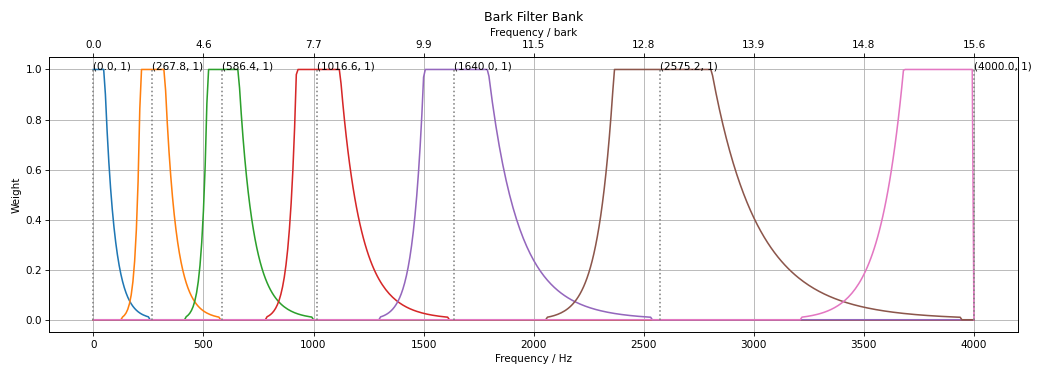spafe.fbanks.bark_fbanks#
Description : Bark filter banks implementation.
Copyright (c) 2019-2024 Ayoub Malek. This source code is licensed under the terms of the BSD 3-Clause License. For a copy, see <https://github.com/SuperKogito/spafe/blob/master/LICENSE>.
- spafe.fbanks.bark_fbanks.Fm(fb: float, fc: float) float[source]#
Compute a Bark filter around a certain center frequency in bark [Hermansky].
- spafe.fbanks.bark_fbanks.bark_filter_banks(nfilts: int = 24, nfft: int = 512, fs: int = 16000, low_freq: float = 0, high_freq: Optional[float] = None, scale: typing_extensions.Literal[ascendant, descendant, constant] = 'constant', conversion_approach: typing_extensions.Literal[Wang, Tjomov, Schroeder, Terhardt, Zwicker, Traunmueller] = 'Wang')[source]#
Compute Bark filter banks. The filters are stored in the rows, the columns correspond to fft bins.
- Parameters
nfilts (int) – the number of filters in the filter bank. (Default is 20).
nfft (int) – the FFT size. (Default is 512).
fs (int) – sample rate/ sampling frequency of the signal. (Default 16000 Hz).
low_freq (float) – lowest band edge of mel filters. (Default 0 Hz).
high_freq (float) – highest band edge of mel filters. (Default is fs/2).
scale (str) – monotonicity behavior of the filter banks. (Default is “constant”).
conversion_approach (str) – bark scale conversion approach. (Default is “Wang”).
- Returns
(numpy.ndarray) : array of size nfilts * (nfft/2 + 1) containing filter bank. Each row holds 1 filter.
(numpy.ndarray) : array of center frequencies
- Return type
(tuple)
- Raises
ParameterError –
if low_freq < 0 OR high_freq > (fs / 2)
Tip
scale: can take the following options [“constant”, “ascendant”, “descendant”].conversion_approach: can take the following options [“Tjomov”,”Schroeder”, “Terhardt”, “Zwicker”, “Traunmueller”, “Wang”]. Note that the use of different options than the ddefault can lead to unexpected behavior/issues.
References
- Hermansky
Hermansky, H. “Perceptual linear predictive (PLP) analysis of speech.” The Journal of the Acoustical Society of America 87 4 (1990): 1738-52 doi: 10.1121/1.399423. PMID: 2341679.
Examples
import numpy as np from spafe.utils.converters import bark2hz from spafe.utils.vis import show_fbanks from spafe.fbanks.bark_fbanks import bark_filter_banks # init var fs = 8000 nfilt = 7 nfft = 1024 low_freq = 0 high_freq = fs / 2 # compute freqs for xaxis bhz_freqs = np.linspace(low_freq, high_freq, nfft //2+1) for scale, label in [("constant", ""), ("ascendant", "Ascendant "), ("descendant", "Descendant ")]: # bark fbanks bark_fbanks_mat, bark_freqs = bark_filter_banks(nfilts=nfilt, nfft=nfft, fs=fs, low_freq=low_freq, high_freq=high_freq, scale=scale) # visualize filter bank show_fbanks( bark_fbanks_mat, [bark2hz(freq) for freq in bark_freqs], bhz_freqs, label + "Bark Filter Bank", ylabel="Weight", x1label="Frequency / Hz", x2label="Frequency / bark", figsize=(14, 5), fb_type="bark", )



